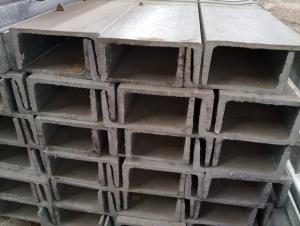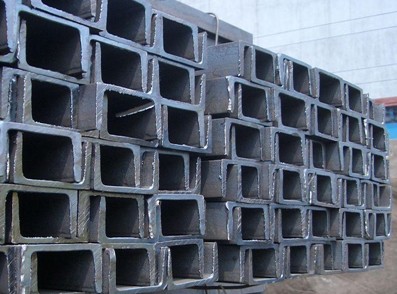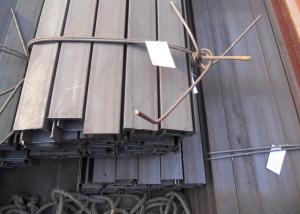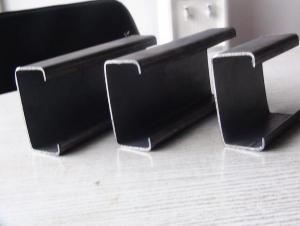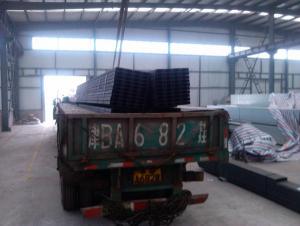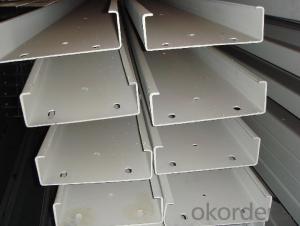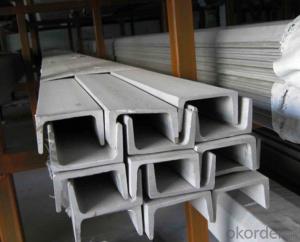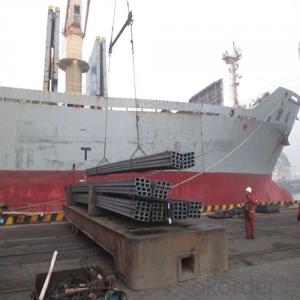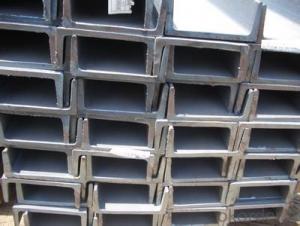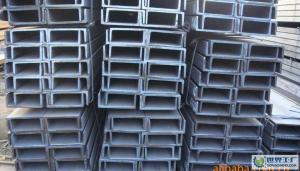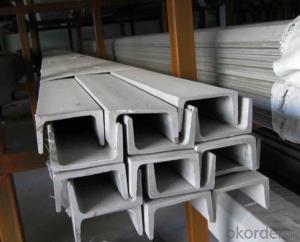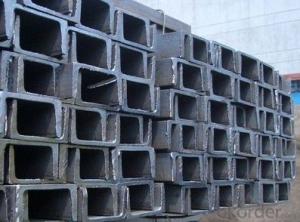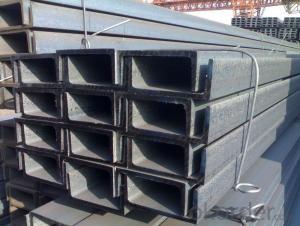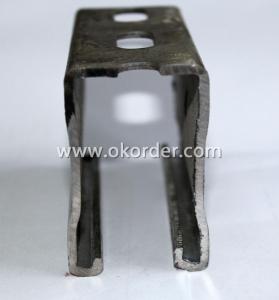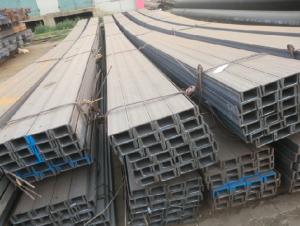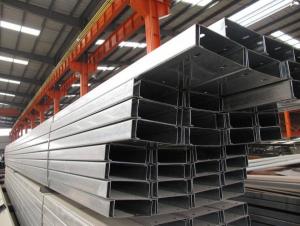CHANNEL JIS G3192 SS400 GB Q235 Q345 Hot Rolled
- Loading Port:
- China Main Port
- Payment Terms:
- TT or LC
- Min Order Qty:
- -
- Supply Capability:
- -
OKorder Service Pledge
OKorder Financial Service
You Might Also Like
Product Description:
OKorder is offering high quality CHANNEL JIS G3192 SS400 GB Q235 Q345 Hot Rolledat great prices with worldwide shipping. Our supplier is a world-class manufacturer of steel, with our products utilized the world over. OKorder annually supplies products to European, North American and Asian markets. We provide quotations within 24 hours of receiving an inquiry and guarantee competitive prices.
Product Applications:
1.The JIS U Channel Steel can be devided into two kinds, namely common channel steel and light channel steel. The sizes of hot rolled common channel steel range from 5# to 40#. Meanwhile, the channel steel can be divided into cold forming sectional equal channel steel, cold forming sectional unequal channel steel, cold forming inner edge channel steel and outer edge channel steel.
2.The JIS u channel steel is usually used for arch-itechtural structure, and they could be welded in order to support or hang a vari-ety of facilities. They are also usually used in combination with I beam. The channel steel with sizes under 14# is usually applied to construction engineering, as purline, while the channel steel with sizes above 16# is more likely to be used in building vehicle chassis structure and mechanical structure. Furthermore, the channel steel in sizes above 30# are target at building bridge structure, as tension bar.
Product Advantages:
OKorder's CHANNEL JIS G3192 SS400 GB Q235 Q345 Hot Rolled are durable, strong, and resist corrosion.
Main Product Features:
· Premium quality
· Prompt delivery & seaworthy packing (30 days after receiving deposit)
· Corrosion resistance
· Can be recycled and reused
· Mill test certification
· Professional Service
· Competitive pricing
Product Specifications:
Manufacture: Hot rolled
Grade: Q195 – 235
Certificates: ISO, SGS, BV, CIQ
Length: 6m – 12m, as per customer request
Packaging: Export packing, nude packing, bundled
Original Place | Tangshan, China | Brand Name | UINDA |
Standard | JIS G3192 : 1990 | ||
Material Grade | SS490 | ||
Sizes | 50mm to 200mm | ||
Sales Volume/Year | 3000MT | ||
Destination Area | Middle East, Africa, Southeast Asia | ||
2. The sections in details are as followings in the table-1
JIS U CHANNEL | Standard | Sectional | Dimension |
| Mass: |
| (mm) | (mm) | (mm) | (mm) |
|
50x25 | 50 | 25 | 3.0 | 6.00 | 2.37 |
75X40 | 75 | 40 | 3.8 | 7.00 | 5.30 |
75X40 | 75 | 40 | 4.0 | 7.00 | 5.60 |
75X40 | 75 | 40 | 4.5 | 7.00 | 5.85 |
75X40 | 75 | 40 | 5.0 | 7.00 | 6.92 |
|
|
|
|
|
|
100X50 | 100 | 50 | 3.8 | 6.00 | 7.30 |
100X50 | 100 | 50 | 4.2 | 6.00 | 8.03 |
100X50 | 100 | 50 | 4.5 | 7.50 | 8.97 |
100X50 | 100 | 50 | 5.0 | 7.50 | 9.36 |
|
|
|
|
|
|
125X65 | 125 | 65 | 5.2 | 6.80 | 11.66 |
125X65 | 125 | 65 | 5.3 | 6.80 | 12.17 |
125X65 | 125 | 65 | 5.5 | 8.00 | 12.91 |
125X65 | 125 | 65 | 6.0 | 8.00 | 13.40 |
|
|
|
|
|
|
150x75 | 150 | 75 | 5.5 | 7.30 | 14.66 |
150x75 | 150 | 75 | 5.7 | 10.00 | 16.71 |
150x75 | 150 | 75 | 6.0 | 10.00 | 17.90 |
150x75 | 150 | 75 | 6.5 | 10.00 | 18.60 |
150x75 | 150 | 75 | 6.5 | 10.00 | 24.00 |
|
|
|
|
|
|
200X80 | 200 | 80 | 7.5 | 11.00 | 24.60 |
3. The mechanical property of JIS U Channel Steel in the table-2:
Grade | Yield Strength,N/mm² | Extension Strength N/mm² | |||
Thickness of Steel,mm | |||||
≦16 | >16-≦40 | >40-≦100 | >100 | ||
SS490 | ≧285 | ≧275 | ≧255 | ≧245 | 490-610 |
4. The chemical composition of JIS U Channel Steel as per SS490 in the table-3
Grade | Element(%) | |||
C | Mn | P | S | |
SS490 | - | - | ≦0.050 | ≦0.050 |
FAQ:
Q1 How do we guarantee the quality of our products?
A1 We have established an advanced quality management system which conducts strict quality tests at every step, from raw materials to the final product. At the same time, we provide extensive follow-up service assurances as required.
Q2ow do you package the angle steel when shipping?
A2l goods are packed in bundles with steel strips and shipped by container or break bulk.
Q3What makes stainless steel stainless?
A3tainless steel must contain at least 10.5 % chromium. It is this element that reacts with the oxygen in the air to form a complex chrome-oxide surface layer that is invisible but strong enough to prevent further oxygen from "staining" (rusting) the surface. Higher levels of chromium and the addition of other alloying elements such as nickel and molybdenum enhance this surface layer and improve the corrosion resistance of the stainless material.
A5: Stainless does not "rust" as you think of regular steel rusting with a red oxide on the surface that flakes off. If you see red rust it is probably due to some iron particles that have contaminated the surface of the stainless steel and it is these iron particles that are rusting. Look at the source of the rusting and see if you can remove it from the surface.
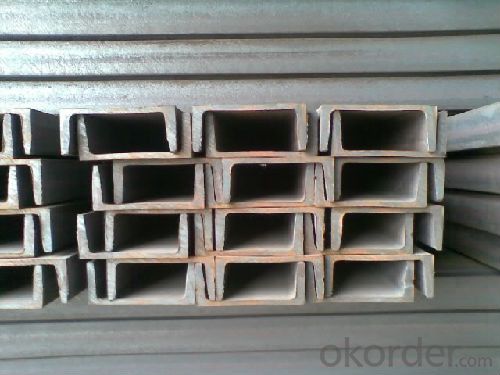
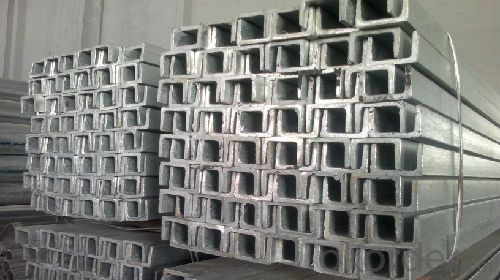
- Q: The pressure is: 50TLength: 1 meters or soMaterial: steel or steelSpecifications: please tell me how much you can use!Prawns help you ah! Urgent! Online, etc.!
- Am I a prawn? Then you use channel 5
- Q: How do steel channels compare to other types of steel profiles?
- When comparing steel channels to other steel profiles, it becomes evident that they possess numerous benefits. Firstly, their high strength and durability are widely recognized. Due to their U-shaped design, steel channels can effectively bear heavy loads without succumbing to bending or warping, making them ideal for structural purposes. Additionally, this strength enables them to withstand extreme weather conditions and external forces, ensuring their longevity. Secondly, steel channels offer exceptional versatility. They can be easily customized and fabricated to meet specific project requirements, making them suitable for a variety of applications, including structural support, framing, and reinforcement. Furthermore, steel channels are available in various sizes and thicknesses, allowing them to be utilized in projects of different scales. Moreover, steel channels exhibit remarkable corrosion resistance. Typically crafted from carbon or stainless steel, which both possess natural anti-corrosion properties, they are well-suited for outdoor and marine environments that are prone to moisture or chemical exposure. Furthermore, steel channels are cost-effective. Being widely available and abundant, steel is relatively affordable compared to other construction materials. Additionally, the durability and longevity of steel channels result in reduced maintenance costs over time, making them a cost-efficient choice for many applications. Lastly, steel channels offer ease of installation. Their uniform shape and standardized dimensions make them simple to work with, thereby reducing installation time and labor costs. This ease of installation also makes steel channels the preferred choice for DIY projects or small-scale constructions. In conclusion, steel channels possess numerous advantages over other steel profiles. Their strength, versatility, corrosion resistance, cost-effectiveness, and ease of installation make them a popular choice for various construction projects.
- Q: What does "deformed L/200" mean in the carrying capacity of channel steel?
- Most of the traditional bridge deflection measurement using a dial gauge or displacement gauge measurement, the current safety assessment in the old bridge or bridge acceptance is still widely used in China, the maintenance of the bridge. The advantage of this method is that the equipment is simple and can be used for multi-point detection. The deflection values of each measuring point are obtained directly, and the measurement results are stable and reliable. But the direct measurement method has many deficiencies, the method requires measuring point pull wire or erection shelf at all, to be measured directly with water under the bridge so; to overpass, affected by railway or highway traffic bound, the method can also be used; across the canyon and other Takahashi also cannot use the direct method of measurement in addition to using direct method; deflection measurement, regardless of layout or revoke the instrument, are relatively complicated time-consuming.
- Q: What are the different types of connections for steel channels in modular construction?
- Some of the different types of connections for steel channels in modular construction include bolted connections, welded connections, and bracket connections.
- Q: How do steel channels perform in high-temperature industrial applications?
- The excellent performance capabilities of steel channels make them widely used in high-temperature industrial applications. Their high heat resistance is one of their key advantages in such environments. Steel is a highly durable and heat-resistant material, allowing it to withstand extreme temperatures without deformation or degradation. In high-temperature industrial applications, steel channels maintain their structural integrity even when constantly exposed to elevated temperatures. They can withstand thermal expansion and contraction without warping or bending, ensuring the stability and reliability of the structures they are used in. Additionally, steel channels exhibit excellent corrosion resistance, which is crucial in high-temperature environments where chemicals and gases may be present. This corrosion resistance prevents deterioration even when exposed to aggressive substances, ensuring their longevity and minimizing maintenance requirements. Moreover, steel channels possess high strength and load-bearing capacity, making them suitable for heavy-duty applications in industries such as manufacturing, construction, and oil and gas. Their robustness enables them to support heavy loads and withstand the demands of high-temperature environments without compromising their structural integrity. Furthermore, steel channels are versatile and easily customizable to meet specific requirements. They are available in various sizes, shapes, and thicknesses, allowing for greater flexibility in designing structures for high-temperature industrial applications. This adaptability makes steel channels the preferred choice for engineers and designers working in such industries. In conclusion, steel channels excel in high-temperature industrial applications due to their heat resistance, corrosion resistance, strength, and versatility. They provide reliable and durable components for structures exposed to extreme temperatures, ensuring the necessary stability and functionality for safe and efficient operations in high-temperature environments, whether it be in furnaces, boilers, or other industrial settings.
- Q: How are steel channels transported and stored?
- Various methods are employed to ensure the safety and efficient handling of steel channels during transportation and storage. Transporting steel channels typically involves the use of trucks, trailers, or flatbeds specifically designed to accommodate their length and weight. Lifting equipment, such as cranes or forklifts, is often utilized to securely load the channels onto these vehicles, preventing any damage or shifting during transit. Properly securing the steel channels during transportation is crucial to minimize potential risks or accidents. Straps, chains, or other fastening devices are commonly used to firmly hold the channels in place. Additionally, protective coverings or packaging materials may be employed to shield the channels from external elements like moisture or debris. When it comes to storage, steel channels are typically kept in warehouses or outdoor storage yards. To ensure easy access and maximum space utilization, the channels are usually organized and arranged in a systematic manner. Storing the channels in dry and well-ventilated areas, away from moisture and extreme temperatures, helps prevent corrosion and damage. In warehouses, steel channels are often stored individually or bundled together on racks or shelves designed to provide stability and prevent accidental collapse. Outdoor storage yards may utilize stacking methods or storage racks specifically designed for steel channels. To protect against rust and corrosion, it is common practice to apply a protective coating or paint before storing steel channels. This creates a barrier against environmental factors and extends the channels' lifespan. Regular inspections and maintenance are also necessary to ensure the channels remain in good condition during storage. Overall, careful planning, proper equipment, and adherence to safety protocols are essential in the transportation and storage of steel channels. By following these guidelines, steel channels can be safely transported and stored, ensuring their quality and usability for various construction and industrial applications.
- Q: Can steel channels be used for creating support structures for ventilation systems?
- Support structures for ventilation systems can be created using steel channels. These channels are widely used in construction and engineering because of their durability and strength. They offer a solid framework for supporting the weight of ventilation equipment, including fans, filters, and ductwork. Moreover, steel channels provide design flexibility and can be tailored to meet specific project needs. Furthermore, steel is resistant to corrosion and can withstand harsh environmental conditions, making it suitable for use in moisture or chemical-exposed ventilation systems. Ultimately, steel channels are a dependable option for establishing support structures that guarantee the secure and effective functioning of ventilation systems.
- Q: How do steel channels perform in high-seismic areas?
- Steel channels perform well in high-seismic areas due to their inherent strength and flexibility. The unique shape of steel channels allows them to absorb and distribute seismic forces, minimizing structural damage during earthquakes. Additionally, steel's high strength-to-weight ratio makes it an ideal material for constructing earthquake-resistant buildings and infrastructure.
- Q: What are the different corrosion protection methods for steel channels?
- To enhance the durability of steel channels and prevent corrosion, several corrosion protection methods can be employed. These methods can be broadly classified into surface treatments, coatings, and cathodic protection. Surface treatments involve various techniques that modify the steel channel's surface to make it more resistant to corrosion. One commonly used method is mechanical cleaning, which entails removing dirt, rust, or mill scale using abrasive techniques like sandblasting or wire brushing. Chemical treatments, such as acid pickling, can also be employed to eliminate impurities and create a clean surface. Coatings are another effective method for protecting steel channels against corrosion. These coatings act as a barrier, preventing corrosive substances from coming into contact with the steel surface. Common coating options include paint, epoxy, zinc, or galvanization. Paints and epoxy coatings provide a protective layer, while zinc or galvanization create a sacrificial layer that corrodes instead of the steel channel. Cathodic protection is a technique that safeguards steel channels by utilizing them as the cathode of an electrochemical cell. This method involves installing sacrificial anodes or impressed current systems. Sacrificial anodes, typically made of metals like zinc or magnesium, are connected to the steel channel and corrode instead of the steel, effectively protecting it from corrosion. Impressed current systems, on the other hand, use an external power source to direct a small current onto the steel channel, preventing corrosion. It is important to consider various factors, such as the environment, application, and budget, when selecting a corrosion protection method. Seeking advice from corrosion experts or engineers can assist in determining the most suitable protection method for specific steel channel requirements.
- Q: Can steel channels be used in the construction of railings or handrails?
- Steel channels can indeed be utilized in the construction of railings or handrails due to their strength and durability. Being a suitable material for supporting and securing railings or handrails, steel channels are frequently selected. They can be fabricated and installed with ease, offering a robust structure capable of withstanding heavy loads and guaranteeing the safety of individuals who utilize the railing or handrail. Furthermore, steel channels can be designed in diverse shapes and sizes, allowing for flexibility in creating different railing or handrail designs to meet specific architectural needs.
Send your message to us
CHANNEL JIS G3192 SS400 GB Q235 Q345 Hot Rolled
- Loading Port:
- China Main Port
- Payment Terms:
- TT or LC
- Min Order Qty:
- -
- Supply Capability:
- -
OKorder Service Pledge
OKorder Financial Service
Similar products
Hot products
Hot Searches
Related keywords
